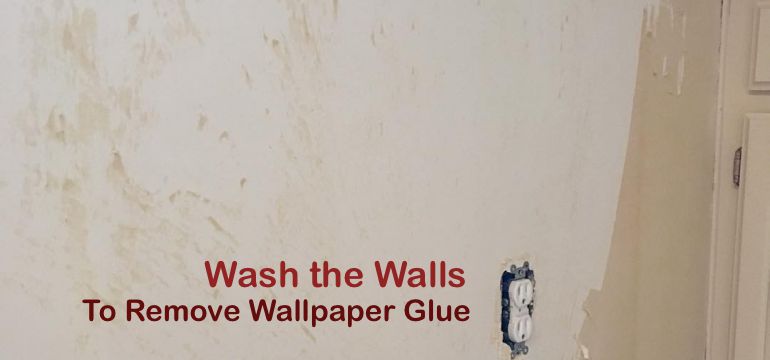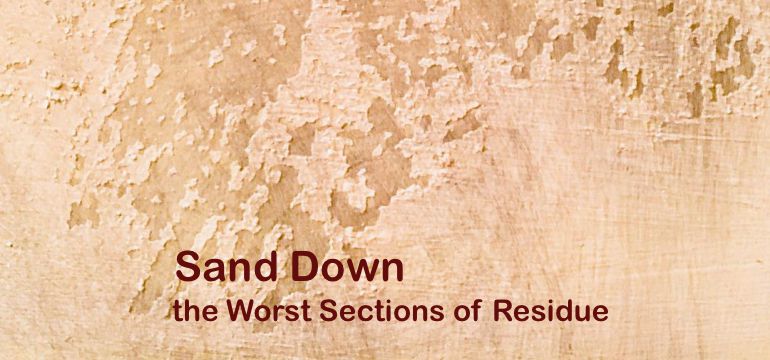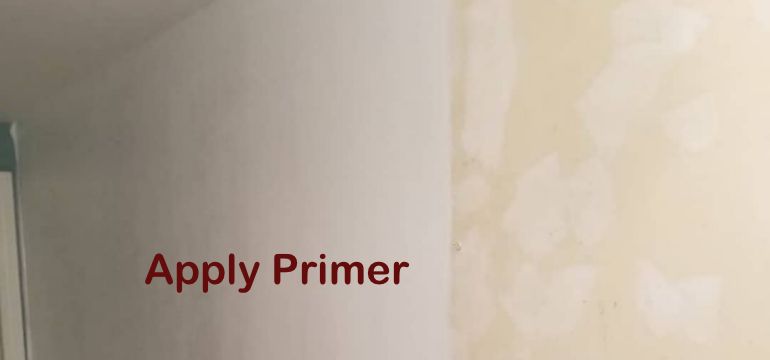Wallpaper is a notorious nightmare for contractors, DIYers, and home renovation experts. For one thing, it’s tough and time-consuming to apply neatly and correctly.
For another, it’s incredibly difficult to remove, and you’re pretty much guaranteed to have wallpaper glue residue left behind on your walls.
Can you paint over wallpaper glue? Yes, you can! Fortunately, with some proven techniques and products, you can reclaim those wallpapered rooms and freshen them up with the paint color of your choice. Check out this guide to painting over wallpaper glue.
Wash the walls to remove wallpaper glue

Let’s assume that you’ve managed to remove all the wallpaper in the room via steamer, hot water, or other methods.
We recommend covering and taping off your floors, baseboards, and furniture, so they don’t become sticky or suffer moisture damage during that initial removal phase. Have plenty of old towels handy to catch the streams of glue and water that will flow down the walls.
Maybe a previous owner did a botched job of wallpaper removal and repainting, and you’re wondering how to remove wallpaper glue that has been painted over once already.
To accomplish this, you’ll need to score or sand down the surface layer of paint. You might need to employ a paint stripper as well. Work slowly and gently in small sections to minimize damage to the underlying walls.
If you find that one method isn’t working, change your strategy. In some cases, a mixture of fabric softener, vinegar, and water in a spray bottle can help with the removal process.
Once you’ve peeled and scraped off all the wallpaper and most of the glue as carefully as you can, wash the entire room again with a mixture of soap and hot water. You don’t want to soak the drywall—you’re simply moistening and scrubbing away any major areas of residue.
Sand down the worst sections of residue

Your next step to painting over wallpaper glue is to take a damp, medium-grit sanding block and scour away any noticeable, thick areas of glue grime. You’ll still have some minimal residue on the walls afterward, and that’s okay.
Your primary objective during this step is to scrub away the lumpy or obvious sections of wallpaper glue residue.
Once you’ve completed the washing and scouring/sanding, rinse the walls one more time, using freshwater and a sponge. Then let the walls dry.
Repair any damage before painting over wallpaper glue
After the walls have dried, take a closer look at them and identify cracks, damaged patches of drywall, holes, and other issues that might get in the way of a nice, clean finish.
Using wall spackle or joint compound and a putty knife, fill in the cracks and crevices. Scrape the compound and sand the areas until they are smooth.
Apply primer in preparation for painting over wallpaper glue

Next, you need a high-quality primer. This may be the most important step in the process and the most vital element to the success of your finished look.
Some DIY home renovators swear by products like Zinsser ALLPRIME Water-Base Problem Surface-Sealer or Gardz Problem Surface Sealer. These products essentially seal off the existing wall surface, covering the wallpaper glue and providing you with a smoothly paintable surface.
Don’t try to skip this step by painting directly onto the wall and its glue residue. Wallpaper glue is water-based, so when it comes in contact with paint, it reactivates, causing a sticky, smudgy mess. You must have the impenetrable barrier of the primer or surface sealer in order to have any success with your painting project.
Primer can actually save you money. Older walls tend to drink up multiple coats of paint and still not look as smooth and rich with color as you want. Those old walls are simply too porous. With the right primer, those porous walls are sealed over, offering you a surface that requires just a couple coats of paint to look perfect. Remember, primers and sealants are strong chemicals, so be sure you have plenty of ventilation in the room while you’re using them.
Paint the walls
Once you’ve waited the correct amount of time after applying the primer, you’re ready to paint the walls! Painting might feel like a vacation after all the work you’ve done to get to this point. Take your time, apply a few coats, then stand back, and admire your work!
If you decide that removing all the wallpaper glue residue is too much effort, you can try painting over wallpaper glue without sanding or scrubbing it. You’ll still have to surface sealer, and you’ll need to be prepared for the lumpy, three-dimensional results due to the bumpy glue residue.
To counteract this effect, choose a textured paint. That way, the uneven look of the wall won’t be as obvious, and it will seem like a style choice rather than a necessity.
Whichever way you decide to deal with your walls, remember that no project is ever perfect. The results are yours to enjoy all the more because of the hard work you put into revamping and revitalizing your space.
- Painting Over Powder Coat and What You Need to Know - February 1, 2022
- How to Get Rid of Humidity in a Basement Without a Dehumidifier - December 17, 2021
- How to Fix a Crack in Drywall That Keeps Coming Back - September 22, 2021

Llori Lang
Monday 13th of July 2020
I removed the wall paper from the walls in a small very tight bathroom. I honestly thought that I had removed all of the glue. i have painted the walls with water based high gloss paint. Now the remnants of glue are showing through with dark patches. How in the world can I fix this ?
Liz
Monday 8th of November 2021
@Llori Lang, Sounds like you need to follow above advice and start sanding down the raised rough spots. Then coat with a sealer/primer. Good luck and have lots of patience!